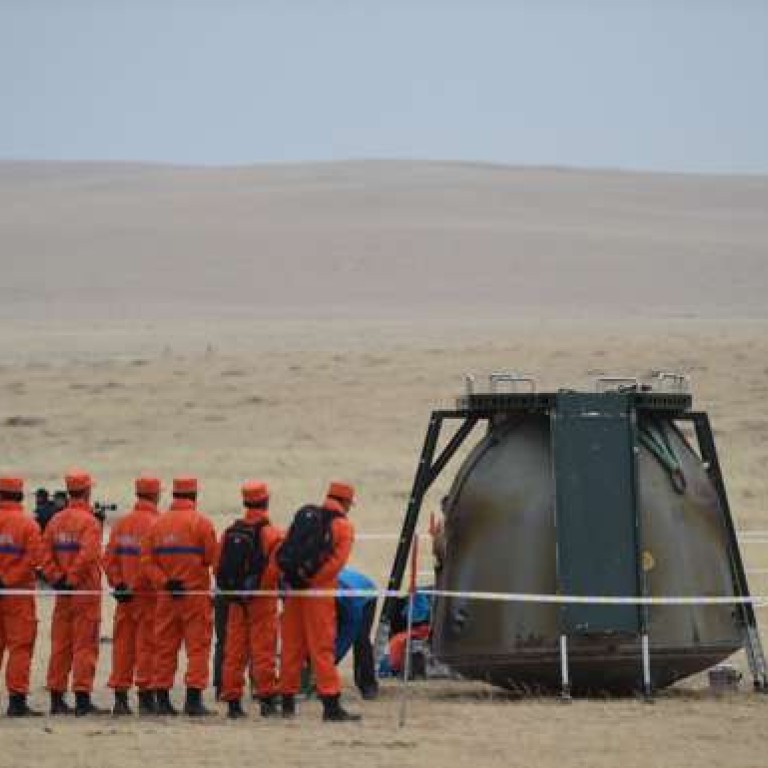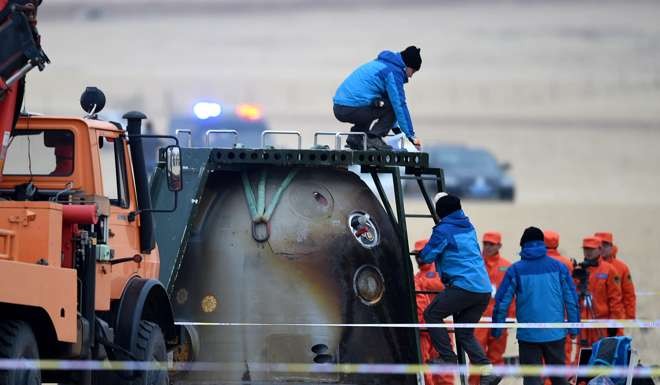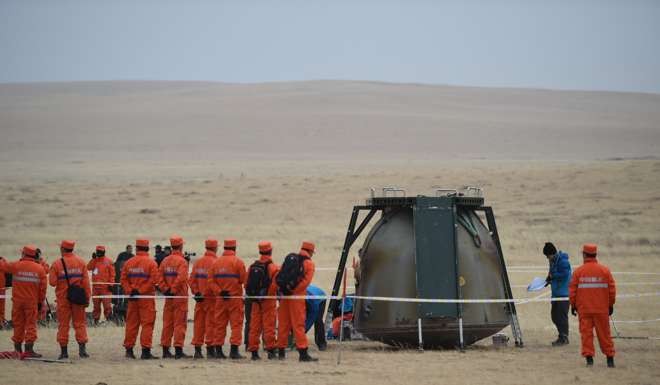
New | What the Chinese astronauts did during their month-long space mission on Tiangong-2
Crew on China’s longest manned space mission return to earth with much data for analysis
China successfully completed its longest manned space mission on Friday when astronauts Jing Haipeng and Chen Dong returned to earth after a month-long stay aboard the Tiangong-2 space laboratory.
The following is some of what the two have done while in space for the past month:

September 15, Launch of the Tiangong-2
The Tiangong-2 was launched from the Gobi Desert and sent into orbit at 10:04pm on the evening of Mid-Autumn Festival. The space lab, with a interior space of 15 cubic metres, was equipped with exercise and entertainment facilities, in addition to scientific equipment.
After the launch, scientists in the command centre tested the lab’s energy and communication systems to verify it was ready to house astronauts.
October 17, Shenzhou-11 blastoff
The Shenzhou-11 spacecraft launched from the Jiuquan Satellite Launch Centre at about 7:30am, carrying the two astronauts to their designated orbit.
It was the third space trip for mission commander Jing Haipeng, who was 49-years-old at the time. Jing’s previous space flights were on the Shenzhou-7 mission in 2008 and the Shenzhou-9 in 2012.
His companion Chen Dong, 37, was making his debut in China’s space programme.
October 19, Home, sweet space home
The Shenzhou-11 successfully docked with the Tiangong-2 space lab at about 3am.
It was the first time a Chinese spacecraft had conducted docking procedures in orbit at an altitude of 393km, where the space station the country plans to build would be situated.
China previously carried out docking in a 343km orbit.
After the vehicles docked successfully, the astronauts “floated” into the research base, which would be their home for the next month.
Later that day, the astronauts transmitted the first episode of a “space journal” they were filming as special correspondents for state-run Xinhua news agency.
Jing said in the video he was satisfied with the decor and colour combination of his new home.
Scientists in Beijing reported that the two had completed their adaption period for the weightless environment.

October 20, Silkworms in space
Jing released a white silkworm and let it float in the air in a video broadcast by Xinhua.
The silkworm could be seen wriggling as it drifted inside the space lab, tethered with silk to Jing’s finger.
Six silkworms were taken into space by the astronauts for an experiment designed by Hong Kong students to study how the larvae would transform in a weightless environment. The astronauts later reported that five of the silkworms had made cocoons in space.
The study was designed by students at the Christian and Missionary Alliance Sun Kei Secondary School.
The astronauts also performed experiments designed by students at Hong Kong’s Shun Tak Fraternal Association Yung Yau College and Po Leung Kuk Laws Foundation College.
The three projects were the winners of a 2015 space experiment design competition organised by Hong Kong’s Home Affairs Bureau and the China Manned Space Agency.
October 30, Health checks
During the mission, the astronauts performed regular health examinations for a project studying their cardiovascular functions in space.
Chen said it was a challenge to locate the right organs for ultrasound scans, as some organs had moved slightly in the weightless environment.
He said he once mixed up the artery and vein in his neck during a health check because the vein had become as thick as the artery in the zero gravity environment.
October 24, Happy Birthday!
Jing celebrated his 50th birthday with two cans of cheesecake that ground workers in Beijing had prepared for him as a birthday surprise.
November 4, Dinner is served
Jing filmed a video in which he described the food options he and Chen had in space.
The crew was provided with more than 100 types of food and drink for their month-long mission, with their menu including fried rice, quail eggs, spicy pork and Chinese tea.
To enjoy tea in space, the astronauts had to put tea packs into a bag, inject the bag with cold water and then warm the bag with a heating device.
November 7, Personal training
The astronauts worked out on stationary bikes and performed strength exercises using resistance bands in a video broadcast by Xinhua.
The two also worked out on treadmills, becoming the first Chinese astronauts to do so in space, the news agency said. It was no easy task and Jing spent two days learning how to run in space. On the third day, he was able to run on the treadmill for an hour.
The astronauts wore specially-designed “penguin suits” while working out.The suits applied additional pressure to parts of the astronauts’ bodies to protect them from muscle and spine injuries.
Compared with earlier missions, the Shenzhou-11 crew could suffer more severe health problems because of their longer time in space, a spokeswoman for the space programme told reporters earlier.
November 9, Presidential call
President Xi Jinping spoke with the astronauts via a video link, with the call broadcast on state-run television.
Xi said he hoped the two would “complete the following tasks perfectly”.
The president had earlier said the country would establish itself as a strong space power.
The astronauts were shown standing still in the zero gravity space lab as they saluted the president.
November 11, Green thumbs
The astronauts filmed a video as they took care of lettuce plants in the space lab.
It was the first time Chinese astronauts had attempted to grow plants in space.
The seeds started to sprout on the fifth day after they were brought into the lab. With the help of artificial lighting, the plants continued to grow in a container made from nylon materials using a 3D printer.
The astronauts said they spent 10 minutes each day caring for the vegetables, watering them by injecting water into the container by syringe. They also used tweezers to remove any sprouts that were not growing well.
Three days before their departure from the space lab, Jing and Chen collected samples of lettuce leaves for scientific analysis once they returned home.
A scientist quoted by Xinhua said astronauts would be able to eat the plants they grew during future space trips if the samples were found to contain few bacteria.
November 16, Ready to leave
The astronauts finished their last day’s work and readied for their return home.
They packed up the silkworms, lettuce plants and equipment they would take on their return trip.
Samples of their urine and saliva as well as bacteria they collected from the atmosphere were also packed to be brought back to earth for analysis.
The duo cleaned the lab and loaded their rubbish into the orbital module of the Shenzhou-11, which would be burned up on re-entry to the atmosphere.
November 17, Parting ways
The Shenzhou-11 spacecraft separated from the Tiangong-2 at 12:41pm, marking the end of the duo’s month-long mission, with the astronauts secured in a landing module that would deliver them back to earth.
A “space science lesson” hosted by the duo and Shenzhou-10 female astronaut Wang Yaping was published by Xinhua. In the video, Jing wore a brainwave sensor and tried to control a computer through thought commands. They were also filmed practising Kung Fu in the space lab.
November 18, Touchdown
The astronauts touched down at about 2pm on grasslands of the Inner Mongolia autonomous region.
The duo arrived in Beijing shortly before 8pm, where they were carried from their plane on chairs. The aircraft also carried the samples the astronauts brought back from their space experiments.
The Tiangong-2 space lab will remain in orbit before its scheduled docking with the Tianzhou-1 cargo spacecraft in April 2017.

